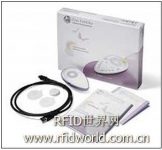
New UK company uses RFID technology to track female ovulation
[ad_1]
Cambridge Temperature Concepts (CTC) is a company established by graduate students from the University of Cambridge. The company uses RFID technology to develop a system-DuoFertility, to help women trying to become pregnant better track and predict their ovulation cycle. CTC started selling this set of products in Europe last month and is expected to sell it in North America early next year.
A woman’s body temperature rises by 0.5-1 degree Celsius during ovulation-this change cannot be detected by ordinary glass thermometers. Therefore, women trying to conceive have been using special thermometers to track subtle changes in body temperature for a long time to determine whether they are in the ovulation period; however, this requires them to keep measuring every day, even as soon as they wake up in the morning.
DuoFertility can make this process more simplified and precise, said Shamus Husheer, president of CTC. The DuoFertility system is mainly composed of two components: a small ring-shaped waterproof module with a base temperature sensor and a passive 125 kHz RFID inlay, a handheld device with an RFID reader, a USB port and indicator for user input Other data for tracking, including pain during ovulation or the results of other fertility tests performed at the same time, such as urine hormone levels.

DuoFertility kit
The module is placed under two armpits, records thousands of temperature readings every day, and the data is stored in 2 megabytes of memory. An adhesive pad-included in the DuoFertility kit-can hold the module under the armpit for up to 28 days. However, the user can remove the module at any time. For example, when the user goes out, the module can be temporarily removed when the clothes cannot conceal the module; when returning, the module can be repositioned with a new adhesive pad. The diameter of the module is 3.5 cm and the thickness is 7 mm.
When the user wants to download the temperature data, she only needs to move the handset close to the module (RF transmission will penetrate the clothing layer). When the temperature and the data she entered into the reader are collected, the handheld device will remind the user of the fertility of the day, and predict the fertility level of the next 5 days based on the color of the indicator (the darker the green light, the higher the level).
The user can also use the USB cable to plug the handheld device into the computer, download the data to the DuoFertility software, generate a chart, and mark her ovulation cycle and fertility level in detail. In addition, the software can also generate specific charts for doctors or fertility specialists to view. You can also charge the reader battery by connecting the reader to the computer.

The system uses 125 kHz RFID tags and sensors, and a handheld RFID reader
“An important advantage of our product is that the average power consumption of the sensor is less than 1 microampere, and the sensor’s lithium battery can run for several months. The sensor uses an 8-byte microprocessor to process and compress the temperature reading data. The process takes about a few seconds. The module’s 2 megabytes of memory stores up to one month of data. Since the system uses passive RFID tags to send information to the reader, the data transfer does not consume the module battery, which also helps to extend the battery life.
Due to the large amount of data transmission in the application, Husheer stated that CTC cannot use any existing tags and readers to use the RFID air interface protocol to communicate with each other. Instead, he said, the company specifically designed an air interface protocol for the DuoFertility application.
In addition, the data transfer between the tag and the reader is encrypted. “The tag and the reader have completed the key exchange when they are produced,” Husheer said. This ensures the security and uniqueness of the module and the reader, and prevents unauthorized third parties from using different readers to collect module data. If the user loses the block or loses the original module, she can order a new module and create a new set of keys online through the software.
The price of the DuoFertility kit is $807 and can be ordered online.
[ad_2]


